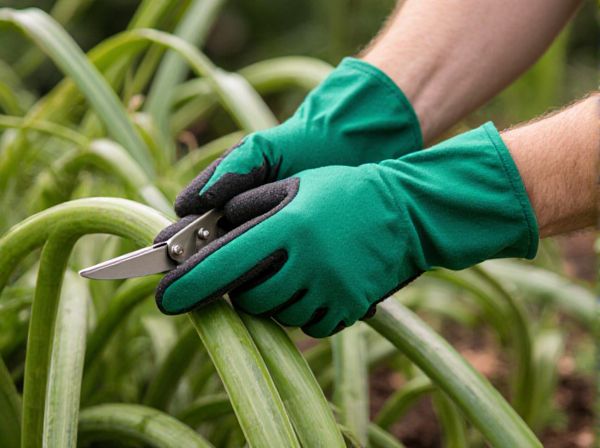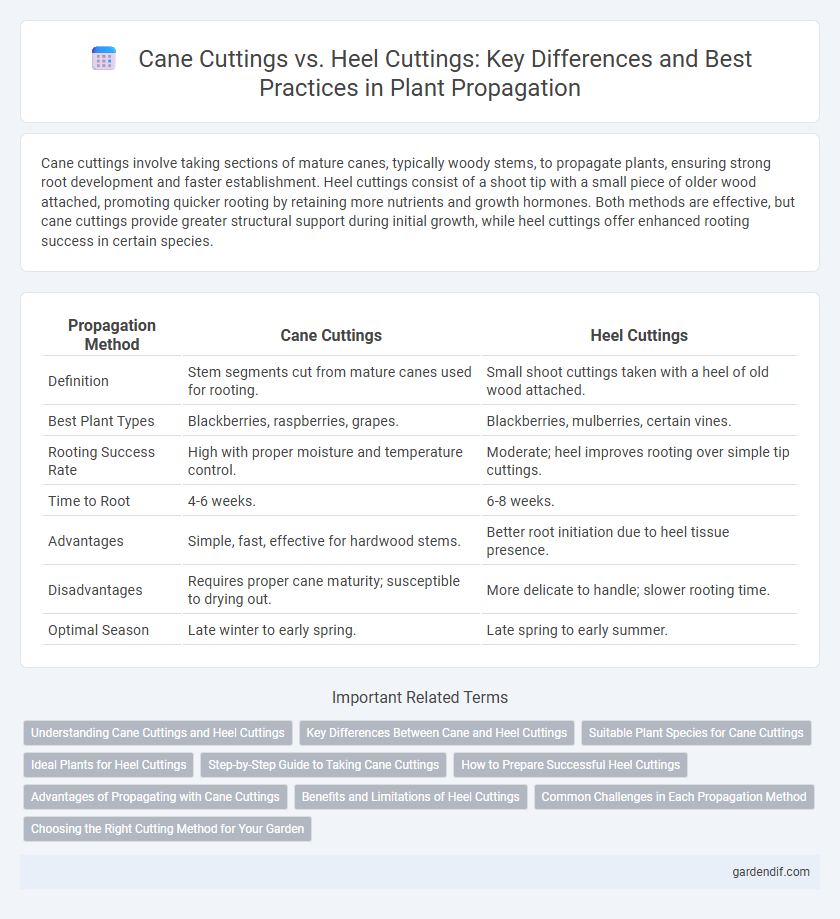
Cane Cuttings vs Heel Cuttings Illustration
Cane cuttings involve taking sections of mature canes, typically woody stems, to propagate plants, ensuring strong root development and faster establishment. Heel cuttings consist of a shoot tip with a small piece of older wood attached, promoting quicker rooting by retaining more nutrients and growth hormones. Both methods are effective, but cane cuttings provide greater structural support during initial growth, while heel cuttings offer enhanced rooting success in certain species.
Table of Comparison
| Propagation Method | Cane Cuttings | Heel Cuttings |
|---|---|---|
| Definition | Stem segments cut from mature canes used for rooting. | Small shoot cuttings taken with a heel of old wood attached. |
| Best Plant Types | Blackberries, raspberries, grapes. | Blackberries, mulberries, certain vines. |
| Rooting Success Rate | High with proper moisture and temperature control. | Moderate; heel improves rooting over simple tip cuttings. |
| Time to Root | 4-6 weeks. | 6-8 weeks. |
| Advantages | Simple, fast, effective for hardwood stems. | Better root initiation due to heel tissue presence. |
| Disadvantages | Requires proper cane maturity; susceptible to drying out. | More delicate to handle; slower rooting time. |
| Optimal Season | Late winter to early spring. | Late spring to early summer. |
Understanding Cane Cuttings and Heel Cuttings
Cane cuttings consist of mature, hardened stems typically harvested from the previous season's growth, ensuring high nutrient reserves for successful rooting. Heel cuttings include a small portion of the parent plant's older woody material attached to the cutting, which can enhance rooting potential by preserving cambium tissue. Both methods are vital in propagation, with cane cuttings preferred for hardwood plants and heel cuttings often used in species requiring more vigorous root initiation.
Key Differences Between Cane and Heel Cuttings
Cane cuttings consist of long, mature stems removed from healthy plants, typically containing multiple nodes and requiring rooting hormone to enhance root development. Heel cuttings include a small sliver of mature wood attached at the base of the young shoot, promoting quicker root formation due to retained cambium tissue. Cane cuttings are ideal for woody plants with hardened stems, while heel cuttings work best for semi-hardwood or softwood propagation due to their higher success rates in root initiation.
Suitable Plant Species for Cane Cuttings
Cane cuttings are most suitable for semi-hardwood plants such as grapes, blackberries, and roses, where the cane retains some flexibility but has matured beyond the soft green stage. These cuttings root efficiently due to the cane's stored nutrients and cambium layer, supporting faster callus formation and root development. Species with thick, woody canes that exhibit moderate lignification respond best to cane cuttings in propagation.
Ideal Plants for Heel Cuttings
Heel cuttings are ideal for semi-hardwood plants such as camellias, azaleas, and gardenias, where a portion of older, woody stem tissue aids in rooting. This propagation method benefits plants that produce tougher stems, allowing for better moisture retention and enhanced root development compared to softwood cuttings. Plants like rhododendrons and holly often respond well to heel cuttings due to their semi-mature wood structure.
Step-by-Step Guide to Taking Cane Cuttings
Select healthy canes with several nodes and cut a 6-8 inch section just below a node to prepare cane cuttings. Remove lower leaves and dip the base in rooting hormone to increase root development success. Plant the cutting in well-draining soil or propagation mix, maintain consistent moisture, and provide indirect sunlight until roots establish.
How to Prepare Successful Heel Cuttings
Prepare successful heel cuttings by selecting healthy, semi-hardwood shoots with a small portion of bark and wood attached at the base. Carefully remove a portion of bark and slightly wedge the heel cuttings into a moist rooting medium, ensuring good contact for optimal moisture retention. Maintain consistent humidity and warmth to encourage root development, typically achieved using misting systems or humidity domes.
Advantages of Propagating with Cane Cuttings
Cane cuttings offer higher success rates in propagation due to their mature wood structure, which contains more stored nutrients essential for root development. They typically root faster and produce more vigorous plants compared to heel cuttings, which originate from softer, younger tissues. This method is ideal for woody plants requiring robust growth and improved disease resistance.
Benefits and Limitations of Heel Cuttings
Heel cuttings offer enhanced root formation due to the inclusion of a portion of the parent stem, improving the survival rate in propagation compared to cane cuttings. They retain moisture longer and exhibit better nutrient absorption, which accelerates establishment in soil. However, heel cuttings require more careful handling to prevent damage and are less suitable for large-scale propagation due to their labor-intensive preparation.
Common Challenges in Each Propagation Method
Cane cuttings often face challenges such as fungal infections and drying out due to their exposed nodes and slender structure, which require consistent moisture and airflow management. Heel cuttings may struggle with slower root development and susceptibility to rot because the heel portion contains more mature tissue that can retain excess moisture. Both methods demand precise environmental control and careful handling to maximize rooting success and minimize common propagation failures.
Choosing the Right Cutting Method for Your Garden
Choosing the right cutting method for propagation depends on the plant species and environmental conditions; cane cuttings are ideal for woody plants like roses and blackberries, offering robust growth from mature stems. Heel cuttings, taken with a small portion of older stem attached, improve rooting success in plants such as camellias and azaleas that have harder, older wood. Understanding the specific needs of your garden's flora ensures higher survival rates and more efficient propagation results.
Cane Cuttings vs Heel Cuttings Infographic

 gardendif.com
gardendif.com